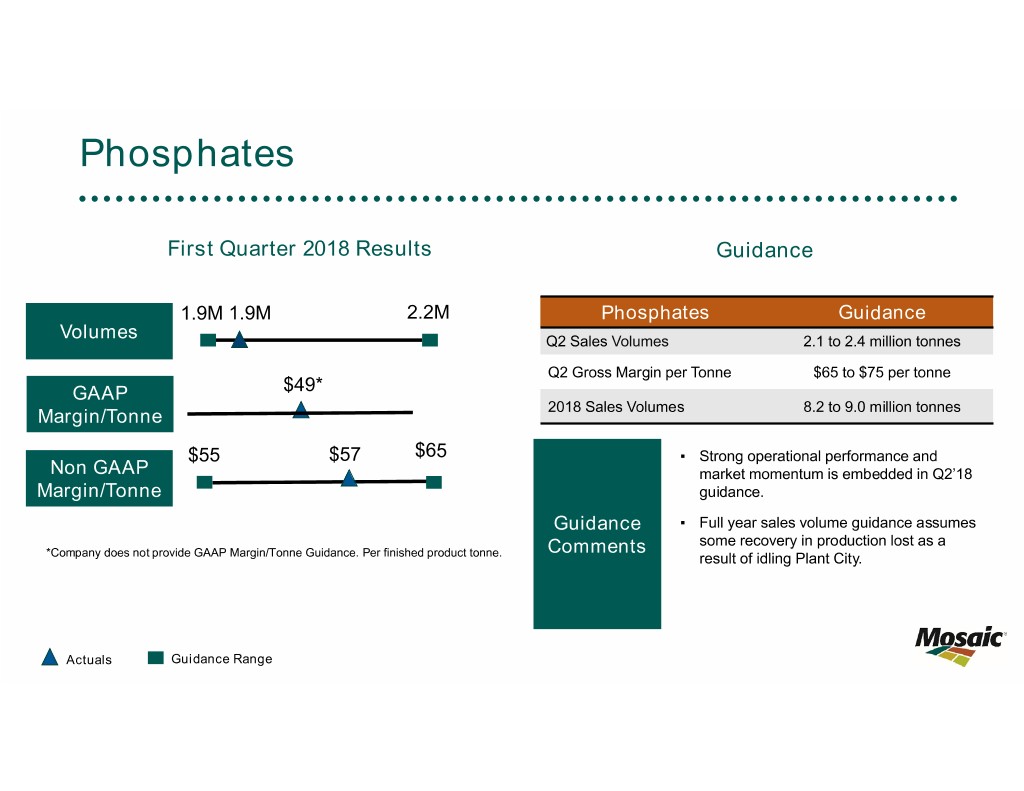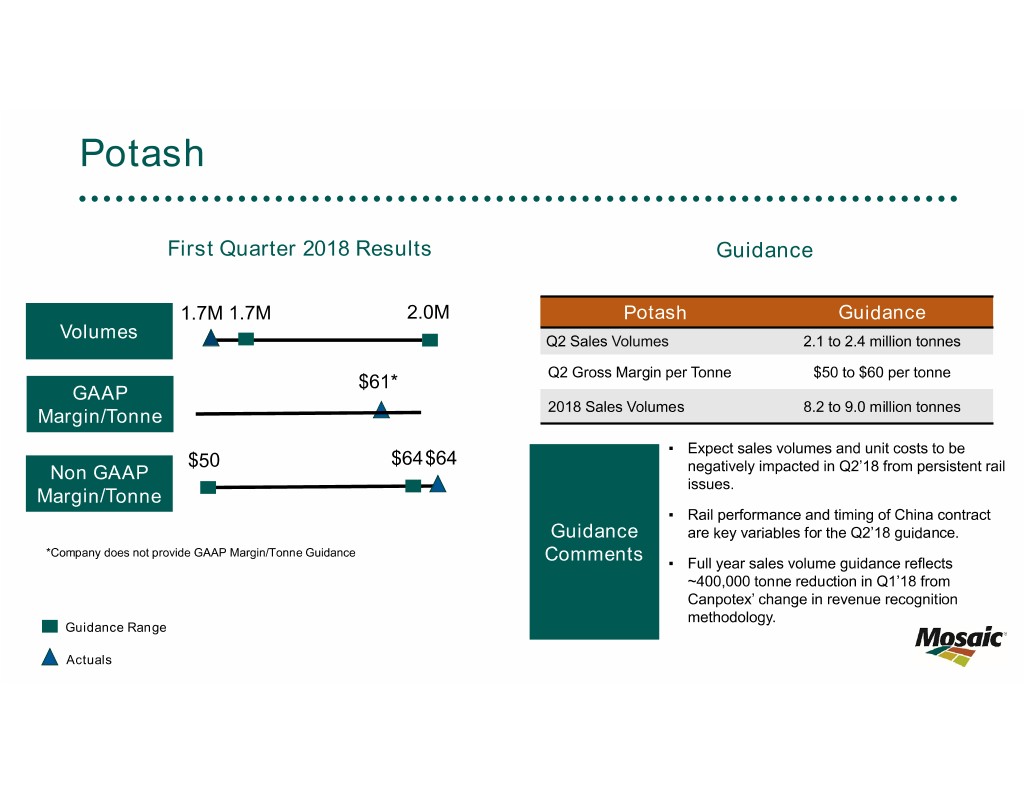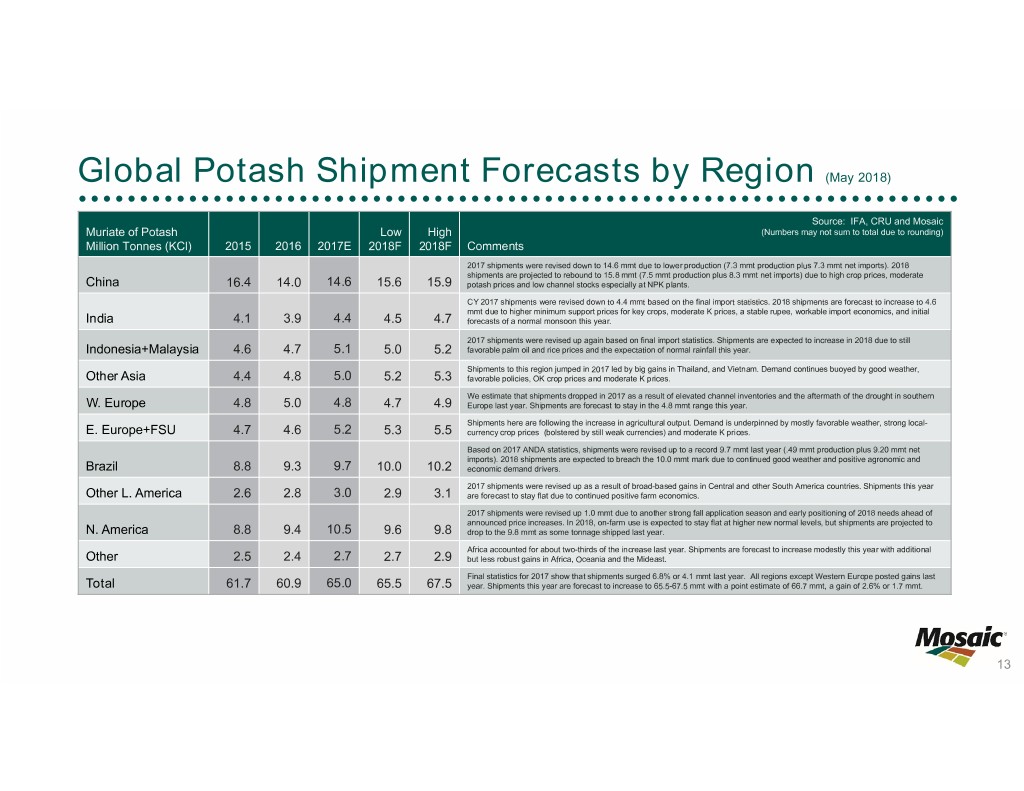Attached files
| file | filename |
|---|---|
| 8-K - 8-K - POST EARNINGS CALL, NEW CFO AND ANNUAL MEETING RESULTS - MOSAIC CO | a8-k2018annualmeetingofsto.htm |
| EX-99.3 - EXHIBIT 99.3 - INVESTOR INVORMATION - SECOND QUARTER 2018 - MOSAIC CO | investorinformationmay20.htm |
| EX-99.1 - EXHIBIT 99.1 - Q1 2018 EARNINGS CALL TRANSCRIPT - MOSAIC CO | q12018earningstranscript.htm |

The Mosaic Company Earnings Conference Call – First Quarter 2018 Joc O’Rourke, President and Chief Executive Officer Presenters: Laura Gagnon, Vice President Investor Relations Date: May 8, 2018

Forward Looking Statements This presentation contains forward-looking statements within the meaning of the Private Securities Litigation Reform Act of 1995. Such statements include, but are not limited to, statements about the anticipated benefits and synergies of our acquisition of the global phosphate and potash operations of Vale S.A. previously conducted through Vale Fertilizantes S.A. (which, when combined with our legacy distribution business in Brazil, is now known as Mosaic Fertilizantes) (the “Transaction”), other proposed or pending future transactions or strategic plans and other statements about future financial and operating results. Such statements are based upon the current beliefs and expectations of The Mosaic Company’s management and are subject to significant risks and uncertainties. These risks and uncertainties include, but are not limited to: difficulties with realization of the benefits and synergies of the Transaction, including the risks that the acquired business may not be integrated successfully or that the anticipated synergies or cost or capital expenditure savings from the Transaction may not be fully realized or may take longer to realize than expected, including because of political and economic instability in Brazil or changes in government policy in Brazil; the predictability and volatility of, and customer expectations about, agriculture, fertilizer, raw material, energy and transportation markets that are subject to competitive and other pressures and economic and credit market conditions; the level of inventories in the distribution channels for crop nutrients; the effect of future product innovations or development of new technologies on demand for our products; changes in foreign currency and exchange rates; international trade risks and other risks associated with Mosaic’s international operations and those of joint ventures in which Mosaic participates, including the performance of the Wa’ad Al Shamal Phosphate Company (also known as MWSPC), the ability of MWSPC to obtain additional planned funding in acceptable amounts and upon acceptable terms, the timely development and commencement of operationsof production facilities in the Kingdom of Saudi Arabia, and the future success of current plans for MWSPC and any future changes in those plans; the risk that protests against natural resource companies in Peru extend to or impact the Miski Mayo mine, which is operated by an entity in which we are the majority owner; difficulties with realization of the benefits of our long term natural gas based pricing ammonia supply agreement with CF Industries, Inc., including the risk that the cost savings initially anticipated from the agreement may not be fully realized over its term or that the price of natural gas or ammonia during the term are at levels at which thepricingis disadvantageous to Mosaic; customer defaults; the effects of Mosaic’s decisions to exit business operations or locations; changes in government policy; changes in environmental and other governmental regulation, including expansion of the types and extent of water resources regulated under federal law, carbon taxes or other greenhouse gas regulation, implementation of numeric water quality standards for the discharge of nutrients into Florida waterways or efforts to reduce the flow of excess nutrients into the Mississippi River basin, the Gulf of Mexico or elsewhere; further developments in judicial or administrative proceedings, or complaints that Mosaic’s operations are adversely impacting nearby farms, business operations or properties; difficulties or delays in receiving, increased costs of or challenges to necessary governmental permits or approvals or increased financial assurance requirements; resolution of global tax audit activity; the effectiveness of Mosaic’s processes for managing its strategic priorities; adverse weather conditions affecting operations in Central Florida, the Mississippi River basin, the Gulf Coast of the United States, Canada or Brazil, and including potential hurricanes, excess heat, cold, snow, rainfall or drought; actual costs of various items differing from management’s current estimates, including, among others, asset retirement, environmental remediation, reclamation or other environmental regulation, Canadian resources taxes and royalties, or the costs of the MWSPC, its existing or future funding and Mosaic’s commitments in support of such funding; reduction of Mosaic’s available cash and liquidity, and increased leverage, due to its use of cash and/or available debt capacity to fund financial assurance requirements and strategic investments; brine inflows at Mosaic’s Esterhazy, Saskatchewan, potash mine or other potash shaft mines; other accidents and disruptions involvingMosaic’s operations, including potential mine fires, floods, explosions, seismic events, sinkholes or releases of hazardous or volatile chemicals; and risks associated with cyber security, including reputational loss; as well as other risks and uncertainties reported from time to time in The Mosaic Company’s reports filed with the Securities and Exchange Commission. Actual results may differ from those set forth in the forward-looking statements. 2

Non-GAAP Financial Measures This presentation includes certain non-GAAP financial measures, including adjusted diluted net earnings per share guidance. For important information regarding the non-GAAP measures we present, see “Non-GAAP Financial Measures” in our May 7, 2018 earnings release and the performance data for the first quarter of 2018 that is available on our website at www.mosaicco.com in the “Financial Information – Quarterly Earnings” section under the “Investors” tab. The earnings release and performance data are also furnished as exhibits to our Current Report on Form 8-K dated May 7, 2018. We are not providing forward looking guidance for U.S. GAAP reported diluted net earnings per share or a quantitative reconciliation of forward-looking non-GAAP EPS. Please see “Non-GAAP Financial Measures” in our May 7, 2018 earnings release for additional information. 3

Executive Summary ▪ Raising full year adjusted EBITDA to $1.7B - $1.9B and adjusted EPS guidance 1 to $1.20 - $1.60 per share*: Constructive • Expect to recoup most logistics related shipment delays Outlook • Expect market momentum to continue through 2018 • Ahead of schedule on debt pay-down, targeting $500 million in 2018 2 ▪ Solid execution across three business units, despite logistics related challenges: Strong Execution • Cash costs of mined Florida rock down to $35 per tonne; Cash costs of conversion down to $68 per tonne • MOP cash costs of production flat at $86 per tonne, despite a negative containment related impact 3 ▪ Remarkable progress on Mosaic Fertilizantes transformation: Transformation • Actions taken in Q1’2018 alone expected to deliver $100 million in annualized EBITDA contribution progress • Cadence of realization in 2018: 1/3rd in H1, 2/3rd in H2 *Adjusted EPS guidance now assumes full year effective tax rate of ~30%, up from prior expectation of ~20%. 4

Improving Market Conditions Stripping Margin Phosphate and Potash Prices MOP $ Tonne $ Tonne 300 325 Source: Argus 300 275 275 250 250 225 225 200 200 175 Jan-16 Jul-16 Jan-17 Jul-17 Jan-18 DAP Stripping Margin MOP cfr Brazil 5

Mosaic Fertilizantes First Quarter 2018 Results Guidance 1.3M 1.6M 1.6M Mosaic Fertilizantes Guidance Volumes Q2 Sales Volumes 2.0 to 2.3 million tonnes Q2 Gross Margin per Tonne $20 to $30 per tonne $37* GAAP 2018 Sales Volumes 9.2 to 10.0 million tonnes Margin/Tonne $25 $37 $38 ▪ Q1’18 benefited from impact of acquired inventory. Non GAAP Margin/Tonne ▪ Q2’18 assumptions: maintenance turn-arounds and higher mix of lower margin SSP product; weaker Guidance BRL, stronger MAP prices and higher synergy *Company does not provide GAAP Margin/Tonne Guidance Comments realization. ▪ Full-year sales volume guidance reflects a correction of erroneously included inter-segment sales. Guidance Range Actuals

Phosphates First Quarter 2018 Results Guidance 1.9M 1.9M 2.2M Phosphates Guidance Volumes Q2 Sales Volumes 2.1 to 2.4 million tonnes Q2 Gross Margin per Tonne $65 to $75 per tonne GAAP $49* 2018 Sales Volumes 8.2 to 9.0 million tonnes Margin/Tonne $55 $57 $65 ▪ Strong operational performance and Non GAAP market momentum is embedded in Q2’18 Margin/Tonne guidance. Guidance ▪ Full year sales volume guidance assumes Comments some recovery in production lost as a *Company does not provide GAAP Margin/Tonne Guidance. Per finished product tonne. result of idling Plant City. Actuals Guidance Range

Potash First Quarter 2018 Results Guidance 1.7M 1.7M 2.0M Potash Guidance Volumes Q2 Sales Volumes 2.1 to 2.4 million tonnes Q2 Gross Margin per Tonne $50 to $60 per tonne $61* GAAP 2018 Sales Volumes 8.2 to 9.0 million tonnes Margin/Tonne ▪ Expect sales volumes and unit costs to be $50 $64$64 Non GAAP negatively impacted in Q2’18 from persistent rail issues. Margin/Tonne ▪ Rail performance and timing of China contract Guidance are key variables for the Q2’18 guidance. *Company does not provide GAAP Margin/Tonne Guidance Comments ▪ Full year sales volume guidance reflects ~400,000 tonne reduction in Q1’18 from Canpotex’ change in revenue recognition methodology. Guidance Range Actuals

Capital Allocation Philosophy Further accelerating debt repayment in 2018 9

Appendix 10

Full Year 2018 Guidance Consolidated Full-Year Guidance 2018 Adjusted Earnings Per Share $1.20 to $1.60* Total SG&A $325 to $350 million Adjusted EBITDA $1.7 to $1.9 billion Capital Expenditures $900 million to $1.1 billion *Reflects an increase of 34 million shares (to 386 million shares) as a result of the completion of the Vale Fertilizantes acquisition. 11

Global Phosphate Shipment Forecasts by Region (May 2018) Source: IFA, CRU and Mosaic DAP / MAP / NPS* / Low High (Numbers may not sum to total due to rounding) TSP (Million Tonnes) 2015R 2016R 2017E 2018F 2018F Comments Our forecast for 2018 is little-changed, as we look to see stabilization of domestic phosphate demand after several years of decline. Shipments are projected to tick up modestly as a result of low channel inventories and strong domestic agricultural China 20.1 18.3 17.7 17.7 18.0 commodity prices. Our forecast is more bullish than many third-party expectations, which show a slight decline in demand. Inventories at the start of the year were at the lowest level in three years and have prompted an earlier and stronger return to the market by Indian buyers in Q2. Positive momentum is to projected to continue in 2018, aided by projections for a normal India 9.2 9.2 9.4 9.5 9.8 monsoon and a small lift to the MRP to offset the recent decline in the rupee. Updated trade statistics and third-party data led us to pare back our demand estimates for 2017 slightly, but we believe that the region began 2018 with low channel inventories. Assuming normal weather, we expect demand to grow at a moderate Other Asia/Oceania 9.3 8.3 9.2 9.6 9.8 pace in 2018. Our 2017 estimate is revised higher on upward adjustments to shipments across both Europe and Russia. Broadly flat on-farm Europe demand is projected in 2018 from this higher base, though we project a modest drop in shipments due to some destocking of and FSU 4.9 5.5 6.1 5.7 5.9 the distribution pipeline in Europe. Farm economics look very attractive on recent gains in soybean export prices – boosted by both fears of a China/U.S. trade dispute and higher CME prices – and a weakening of the currency. Coupled with good weather, we project that shipments will Brazil 6.9 7.8 8.2 8.4 8.7 continue to trend higher in 2018, rising upwards of 3% y-o-y. We have revised lower our 2017 shipment estimate, but have left our 2018 estimate little-changed with continued profitable Other Latin America 2.8 3.7 3.4 3.6 3.8 farm economics. Despite the late start to spring fieldwork, early indications are that on-farm demand is holding firm. Steady-to-higher application rates are expected in 2018, and our expectations for acreage remain at 90+ million for both corn and soybean area. We are projecting shipments to be very similar to last year’s level, as there was very little pull-forward of shipments into 2017, North America 8.9 9.4 9.8 9.7 9.9 as was apparent with potash. Our forecasts for Africa and the Middle East have seen only modest revisions. We continue to forecast a continuation of Other 4.2 4.7 4.7 4.8 5.1 moderate demand growth in these regions in 2018. Our 2017 shipment estimate is slightly higher at 68.5 mmt – an increase of 2.4% or 1.6 mmt from 2016. We maintain our call Total 66.2 66.9 68.5 69.1 71.1 on 2018 shipments of 69-71 mmt, with a current point estimate of 69.8 mmt, a gain of 1.8% or 1.2 mmt. 12

Global Potash Shipment Forecasts by Region (May 2018) Source: IFA, CRU and Mosaic Muriate of Potash Low High (Numbers may not sum to total due to rounding) Million Tonnes (KCl) 2015 2016 2017E 2018F 2018F Comments 2017 shipments were revised down to 14.6 mmt due to lower production (7.3 mmt production plus 7.3 mmt net imports). 2018 shipments are projected to rebound to 15.8 mmt (7.5 mmt production plus 8.3 mmt net imports) due to high crop prices, moderate China 16.4 14.0 14.6 15.6 15.9 potash prices and low channel stocks especially at NPK plants. CY 2017 shipments were revised down to 4.4 mmt based on the final import statistics. 2018 shipments are forecast to increase to 4.6 mmt due to higher minimum support prices for key crops, moderate K prices, a stable rupee, workable import economics, and initial India 4.1 3.9 4.4 4.5 4.7 forecasts of a normal monsoon this year. 2017 shipments were revised up again based on final import statistics. Shipments are expected to increase in 2018 due to still Indonesia+Malaysia 4.6 4.7 5.1 5.0 5.2 favorable palm oil and rice prices and the expectation of normal rainfall this year. Shipments to this region jumped in 2017 led by big gains in Thailand, and Vietnam. Demand continues buoyed by good weather, Other Asia 4.4 4.8 5.0 5.2 5.3 favorable policies, OK crop prices and moderate K prices. We estimate that shipments dropped in 2017 as a result of elevated channel inventories and the aftermath of the drought in southern W. Europe 4.8 5.0 4.8 4.7 4.9 Europe last year. Shipments are forecast to stay in the 4.8 mmt range this year. Shipments here are following the increase in agricultural output. Demand is underpinned by mostly favorable weather, strong local- E. Europe+FSU 4.7 4.6 5.2 5.3 5.5 currency crop prices (bolstered by still weak currencies) and moderate K prices. Based on 2017 ANDA statistics, shipments were revised up to a record 9.7 mmt last year (.49 mmt production plus 9.20 mmt net imports). 2018 shipments are expected to breach the 10.0 mmt mark due to continued good weather and positive agronomic and Brazil 8.8 9.3 9.7 10.0 10.2 economic demand drivers. 2017 shipments were revised up as a result of broad-based gains in Central and other South America countries. Shipments this year Other L. America 2.6 2.8 3.0 2.9 3.1 are forecast to stay flat due to continued positive farm economics. 2017 shipments were revised up 1.0 mmt due to another strong fall application season and early positioning of 2018 needs ahead of announced price increases. In 2018, on-farm use is expected to stay flat at higher new normal levels, but shipments are projected to N. America 8.8 9.4 10.5 9.6 9.8 drop to the 9.8 mmt as some tonnage shipped last year. Africa accounted for about two-thirds of the increase last year. Shipments are forecast to increase modestly this year with additional Other 2.5 2.4 2.7 2.7 2.9 but less robust gains in Africa, Oceania and the Mideast. Final statistics for 2017 show that shipments surged 6.8% or 4.1 mmt last year. All regions except Western Europe posted gains last Total 61.7 60.9 65.0 65.5 67.5 year. Shipments this year are forecast to increase to 65.5-67.5 mmt with a point estimate of 66.7 mmt, a gain of 2.6% or 1.7 mmt. 13

Sensitivity Table: Estimated Full Year Impacts ($ in millions) Impacts to PL: Operating Earnings Δ EPS Δ Average MOP Price --> $10/mt $76 $0.11 Average DAP NA Stripping Margin --> $10/mt $87 $0.16 Average Selling Price Mosaic Fertilizantes Production--> $10/mt $38 $0.07 Potash Sales Volume --> 100k mt $13 $0.02 Phosphates Sales Volume --> 100k mt $10 $0.02 Canadian Dollar Change -->$0.01 $14 $0.03 Brazilian Real Change (no hedging)--> $0.10 $27 $0.05 14
